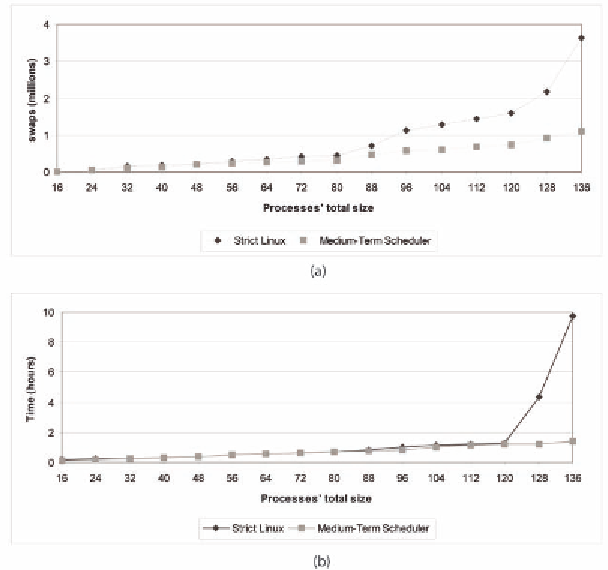Information Technology Reference
In-Depth Information
Figure 2. a. SYN8's Number of Swaps; b. SYN8's Execution Time
an evaluation of the extra size, we used bins of
96MBytes.
of responding to all the paging requests, and
the thrashing becomes acute. The medium-term
scheduler dramatically reduces the number of the
page faults; thus, fewer swaps are performed and
the execution time remains reasonable. Processes
that require 144MB or more were sustainable for
the medium-term scheduler, but not for the Linux
scheduler.
We also employed Matlab formal benchmark.
Matlab benchmark is a very memory consum-
ing process. It takes about 290MB with Matlab
7.0.0.19901 (R14) running on our Linux 2.6.9
machine, but when memory pressure becomes
high, Matlab will be able to continue working when
just 28MB are resident in the physical memory,
whereas 14MB of them are shared memory with
other possible Matlab processes. When we ex-
ecuted several Matlab processes in parallel, the
results were very similar to the synthetic bench-
mark. However, a significantly larger portion of
execution time
Figure 2a and Figure 2b show the performance of
the synthetic benchmark SYN8. Figure 2a shows
the number of swaps that were performed in both
the schedulers as a function of the total size of the
processes, whereas Figure 2b shows the execution
time of SYN8 as a function of the same processes'
total size. In these figures, the medium-term
scheduler time slice was one second.
It can be seen that when the size of the pro-
cesses is too large, Linux starts swapping in and
out many more pages. From roughly 64MB Linux
swaps more pages, but there is no noteworthy
influence on the I/O time, because Linux lets
other processes run while the I/O is performed.
Roughly, from 128MB the I/O buffer is incapable

Search WWH ::

Custom Search